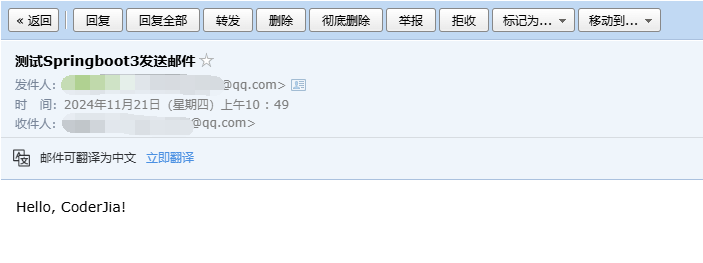在企业应用开发中,发送邮件是一个非常常见的需求,比如用户注册验证、密码重置、系统通知等场景。SpringBoot 3提供了完善的邮件发送支持,本文将详细介绍如何在SpringBoot 3中实现邮件发送功能,并提供最佳实践建议。
1. 环境准备
- JDK 17+
- SpringBoot 3.0+
- Maven/Gradle
2. 项目配置
2.1 添加依赖
在 pom.xml中添加以下依赖:
<dependency>
<groupId>org.springframework.boot</groupId>
<artifactId>spring-boot-starter-web</artifactId>
</dependency>
<dependency>
<groupId>org.springframework.boot</groupId>
<artifactId>spring-boot-starter-mail</artifactId>
</dependency>
<dependency>
<groupId>org.springframework.boot</groupId>
<artifactId>spring-boot-starter-thymeleaf</artifactId>
</dependency>
2.2 配置邮件服务器
在 application.yml中添加邮件服务器配置:
spring:
mail:
host: smtp.qq.com # QQ邮件服务器地址
port: 587 # 端口号
username: ${username}
password: ${password} # 需要去QQ邮箱开通开通POP3/IMAP服务,并设置专用密码
properties:
mail:
smtp:
auth: true
starttls:
enable: true
required: true
thymeleaf:
cache: true
check-template: true
check-template-location: true
content-type: text/html
enabled: true
encoding: UTF-8
excluded-view-names: ''
mode: HTML
prefix: classpath:/templates/
suffix: .html
3. 代码实现
3.1 创建邮件服务接口
package com.example.springboot3email.service;
import org.springframework.web.multipart.MultipartFile;
/**
* @author CoderJia
* @create 2024/11/21 10:22
* @Description
**/
public interface IEmailService {
void sendSimpleEmail(String to, String subject, String text);
void sendHtmlEmail(String to, String subject, String htmlContent);
void sendEmailWithAttachment(String to, String subject, String text, MultipartFile attachment);
}
3.2 实现邮件服务
package com.example.springboot3email.service;
import jakarta.annotation.Resource;
import jakarta.mail.internet.MimeMessage;
import lombok.extern.slf4j.Slf4j;
import org.springframework.beans.factory.annotation.Value;
import org.springframework.core.io.FileSystemResource;
import org.springframework.mail.SimpleMailMessage;
import org.springframework.mail.javamail.JavaMailSender;
import org.springframework.mail.javamail.MimeMessageHelper;
import org.springframework.stereotype.Service;
import org.springframework.web.multipart.MultipartFile;
import java.io.File;
/**
* @author CoderJia
* @create 2024/11/21 10:23
* @Description
**/
@Service
@Slf4j
public class EmailServiceImpl implements IEmailService {
@Resource
private JavaMailSender mailSender;
@Value("${spring.mail.username}")
private String from;
/**
* 发送简单文本邮件
*
* @param to
* @param subject
* @param text
*/
@Override
public void sendSimpleEmail(String to, String subject, String text) {
try {
SimpleMailMessage message = new SimpleMailMessage();
message.setFrom(from);
message.setTo(to);
message.setSubject(subject);
message.setText(text);
mailSender.send(message);
log.info("Simple email sent successfully to: {}", to);
} catch (Exception e) {
log.error("Failed to send simple email", e);
throw new RuntimeException("Failed to send email", e);
}
}
/**
* 发送HTML格式的邮件
*
* @param to
* @param subject
* @param htmlContent
*/
@Override
public void sendHtmlEmail(String to, String subject, String htmlContent) {
try {
MimeMessage message = mailSender.createMimeMessage();
MimeMessageHelper helper = new MimeMessageHelper(message, true, "UTF-8");
helper.setFrom(from);
helper.setTo(to);
helper.setSubject(subject);
helper.setText(htmlContent, true);
mailSender.send(message);
log.info("HTML email sent successfully to: {}", to);
} catch (Exception e) {
log.error("Failed to send HTML email", e);
throw new RuntimeException("Failed to send email", e);
}
}
/**
* 发送带附件的邮件
*
* @param to
* @param subject
* @param text
* @param attachment
*/
@Override
public void sendEmailWithAttachment(String to, String subject, String text, MultipartFile attachment) {
try {
MimeMessage message = mailSender.createMimeMessage();
MimeMessageHelper helper = new MimeMessageHelper(message, true, "UTF-8");
helper.setFrom(from);
helper.setTo(to);
helper.setSubject(subject);
helper.setText(text);
// 创建临时文件
File tempFile = File.createTempFile("upload_", attachment.getOriginalFilename());
attachment.transferTo(tempFile);
// 使用 FileSystemResource 包装临时文件
FileSystemResource file = new FileSystemResource(tempFile);
helper.addAttachment(attachment.getOriginalFilename(), file);
mailSender.send(message);
log.info("Email with attachment sent successfully to: {}", to);
// 删除临时文件
tempFile.delete();
} catch (Exception e) {
log.error("Failed to send email with attachment", e);
throw new RuntimeException("Failed to send email", e);
}
}
}
3.3 创建邮件模板
在 resources/templates目录下创建HTML模板 EmailTemplate.html(使用Thymeleaf):
<!DOCTYPE html>
<html xmlns:th="http://www.thymeleaf.org">
<head>
<title>Email Template</title>
</head>
<body>
<h1>Welcome, <span th:text="${name}">User</span>!</h1>
<p>This is a sample email template using Thymeleaf.</p>
<p>Your verification code is: <strong th:text="${code}">123456</strong></p>
</body>
</html>
3.4 使用模板发送邮件
@Service
public class TemplateEmailService {
@Autowired
private EmailService emailService;
@Autowired
private TemplateEngine templateEngine;
public void sendTemplateEmail(String to, String subject, String templateName, Map<String, Object> variables) {
Context context = new Context();
variables.forEach(context::setVariable);
String htmlContent = templateEngine.process(templateName, context);
emailService.sendHtmlEmail(to, subject, htmlContent);
}
}
4. 最佳实践建议
4.1 异步发送
为避免邮件发送影响主业务流程,建议使用异步方式发送邮件:
@Configuration
@EnableAsync
public class AsyncConfig implements AsyncConfigurer {
@Override
public Executor getAsyncExecutor() {
ThreadPoolTaskExecutor executor = new ThreadPoolTaskExecutor();
executor.setCorePoolSize(5);
executor.setMaxPoolSize(10);
executor.setQueueCapacity(25);
executor.setThreadNamePrefix("EmailAsync-");
executor.initialize();
return executor;
}
}
@Service
public class AsyncEmailService {
@Async
public CompletableFuture<Void> sendEmailAsync(String to, String subject, String content) {
// 邮件发送逻辑
return CompletableFuture.completedFuture(null);
}
}
4.2 重试机制
实现邮件发送重试机制:
@Service
public class RetryableEmailService {
@Retryable(value = {MessagingException.class},
maxAttempts = 3,
backoff = @Backoff(delay = 1000))
public void sendEmailWithRetry(String to, String subject, String content) {
// 邮件发送逻辑
}
@Recover
public void recover(MessagingException e, String to) {
// 处理最终失败的情况
log.error("Failed to send email after retries", e);
}
}
4.3 邮件发送限流
使用令牌桶算法实现邮件发送限流:
@Service
public class RateLimitedEmailService {
private final RateLimiter rateLimiter = RateLimiter.create(10.0); // 每秒10封邮件
public void sendEmailWithRateLimit(String to, String subject, String content) {
if (rateLimiter.tryAcquire()) {
// 发送邮件
} else {
throw new RuntimeException("Rate limit exceeded");
}
}
}
4.4 邮件发送记录
记录邮件发送历史:
@Entity
@Table(name = "email_log")
public class EmailLog {
@Id
@GeneratedValue(strategy = GenerationType.IDENTITY)
private Long id;
private String to;
private String subject;
private LocalDateTime sendTime;
private EmailStatus status;
private String errorMessage;
// getters and setters
}
5. 安全性建议
- 不要在代码中硬编码邮件服务器凭证
- 使用环境变量或配置中心存储敏感信息
- 实现邮件发送频率限制,防止滥用
- 记录邮件发送日志,便于问题排查
- 使用TLS/SSL加密传输
- 定期轮换邮件服务器密码
6. 测试示例
package com.example.springboot3email.controller;
import com.example.springboot3email.service.IEmailService;
import com.example.springboot3email.service.TemplateEmailService;
import jakarta.annotation.Resource;
import lombok.extern.slf4j.Slf4j;
import org.springframework.web.bind.annotation.PostMapping;
import org.springframework.web.bind.annotation.RequestParam;
import org.springframework.web.bind.annotation.RestController;
import org.springframework.web.multipart.MultipartFile;
import java.util.HashMap;
import java.util.Map;
/**
* @author CoderJia
* @create 2024/11/21 10:32
* @Description
**/
@Slf4j
@RestController
public class EmailController {
@Resource
private IEmailService emailService;
@Resource
private TemplateEmailService templateEmailService;
// 发送简单文本邮件接口
@PostMapping("/sendSimpleEmail")
public String sendSimpleEmail(@RequestParam("to") String to,
@RequestParam("subject") String subject,
@RequestParam("text") String text) {
emailService.sendSimpleEmail(to, subject, text);
return "success";
}
// 发送HTML邮件接口
@PostMapping("/sendHtmlEmail")
public String sendHtmlEmail(@RequestParam("to") String to,
@RequestParam("subject") String subject,
@RequestParam("htmlContent") String htmlContent) {
emailService.sendHtmlEmail(to, subject, htmlContent);
return "success";
}
// 发送带附件的邮件接口
@PostMapping("/sendEmailWithAttachment")
public String sendEmailWithAttachment(@RequestParam("to") String to,
@RequestParam("subject") String subject,
@RequestParam("text") String text,
@RequestParam("attachment") MultipartFile attachment) {
emailService.sendEmailWithAttachment(to, subject, text, attachment);
return "success";
}
// 发送模板邮件接口
@PostMapping("/sendTemplateEmail")
public String sendTemplateEmail(@RequestParam("to") String to,
@RequestParam("subject") String subject,
@RequestParam("templateName") String templateName) {
Map<String, Object> variables = new HashMap<>();
variables.put("name", "CoderJia");
variables.put("code", 12530);
templateEmailService.sendTemplateEmail(to, subject, templateName, variables);
return "success";
}
}
发送效果
普通邮件

HTML邮件

带附件邮件

模板邮件

7. 常见问题解决
7.1 连接超时
spring:
mail:
properties:
mail:
smtp:
connectiontimeout: 5000
timeout: 5000
writetimeout: 5000
7.2 SSL证书问题
spring:
mail:
properties:
mail:
smtp:
ssl:
trust: "*"
7.3 中文乱码
helper.setFrom(new InternetAddress(from, "发件人名称", "UTF-8"));
8. 总结
本文详细介绍了在SpringBoot 3中实现邮件发送功能的完整解决方案,包括基本配置、代码实现、最佳实践、安全建议等内容。通过采用异步发送、重试机制、限流等最佳实践,可以构建一个健壮的邮件发送系统。在实际应用中,要根据具体需求选择合适的实现方式,同时注意安全性和性能的平衡。